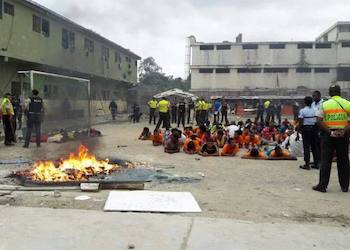A string of inmate deaths after the deployment of extra troops and police to Ecuador’s prisons illustrates that sending in reinforcements is not enough to end the country’s prison crisis.
On July 23, the dead body of an inmate known as “El Gato” was found in the Turi prison, in the city of Cuenca in southern Ecuador, El Universo reported.
The previous day, a riot left two inmates dead and a guard injured in a Latacunga prison, some 90 kilometers to the south of Quito. The violence took place during an inmate uprising in protest of poor prison conditions.
SEE ALSO: Ecuador News and Profile
Twenty-two people in Ecuador’s detention centers have met with violent deaths in 2019, El Universo reported. Of these, 14 have occurred since President Lenin Moreno declared a state of emergency on May 16, which sent the armed forces to secure the perimeters of all the nation’s prisons and the police into jails to provide extra manpower.
InSight Crime Analysis
The state of emergency alone has not prevented this spate of inmate deaths, highlighting that more needs to be done to tackle the worrying issues facing Ecuador’s penitentiary system.
Following the death of six inmates at the Litoral prison, former Prison Director Alfredo Muñoz said the prisons were a “time bomb.”
According to El Universo estimates, the country’s jails are 40 percent over capacity, with 40,006 inmates living in buildings designed to hold up to 28,554 people.
Three gangs — Los Gorras, Los Cubanos and Los Choneros — have also mutated into larger criminal structures that are battling to control drug trafficking and other illicit activities on the streets and within a number of the country’s prisons, according to a report by El Comercio.
As previously reported by InSight Crime, gang conflict intensified after the murder of Los Cubanos’ leader, William Humberto Poveda Salazar, alias “El Cubano,” who was decapitated and burned in a Guayaquil prison on June 11.
In addition, the prison gangs benefit from the flow of drugs, weapons and contraband into the prisons.
SEE ALSO: The Prison Dilemma: Latin America’s Incubators of Organized Crime
During the first six months of the year, searches of cell blocks yielded 1,552 cellphones, 30 kilograms of drugs, 16 firearms, 163 rounds of ammunition, 2,538 liters of liquor, 5,960 knives, 440 electronic devices and $15,436 in cash, Deputy Interior Minister Patricio Pazmiño reported.
Ecuador is also showing worrying signs of state abandonment of prisons, or wholesale participation in criminal activities. This would bring it closer to the likes of Brazil, El Salvador, and Mexico, where gangs are the de facto rulers of many jails with prison authorities often acting as accomplices.
Ecuador’s prisons suffer from a lack of investment and resources while prison guards are overworked and underpaid, both of which facilitate corruption. A prison official previously told InSight Crime that drugs and weapons were moved into the prisons by high-ranking officials and even prison directors.

